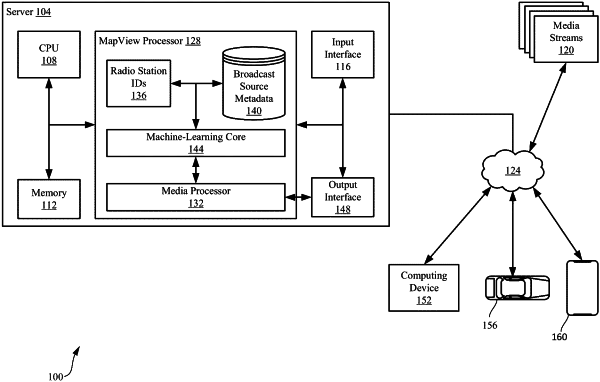| CPC H04L 65/611 (2022.05) [G06N 20/00 (2019.01); H04H 60/46 (2013.01); H04H 60/54 (2013.01); H04H 60/70 (2013.01); H04L 67/12 (2013.01); H04L 67/52 (2022.05)] | 20 Claims |

|
1. A method comprising:
receiving a first positioning signal indicating a first geographical location of a user device;
executing a machine-learning model using the first geographical location and an identification of the user device, wherein the machine-learning model is configured to output an identification of a first set of broadcast sources that are within a predetermined distance from the first geographical location, and wherein the first set of broadcast sources are broadcast sources that are likely to be of interest to a user of the user device;
generating, based on the first geographical location of the user device and the first set of broadcast sources, a graphical user interface including a representation of a geographical area including the first geographical location, wherein the graphical user interface includes a set of icons representing locations of the first set of broadcast sources within the geographical area;
determining, based on the first positioning signal, a first media stream associated with an icon of the set of icons, wherein the first media stream is configured to be presented by the user device, and wherein the first geographical location is within a broadcast range of the first media stream;
facilitating a presentation of the first media stream over an Internet connection of the user device;
receiving a second positioning signal indicating a second geographical location of the user device, wherein the second geographical location is outside the broadcast range of the first media stream;
updating, based on the second geographical location of the user device, the graphical user interface to include a representation of a new geographical area including the second geographical location, wherein the machine-learning model is configured to output an identification of a second set of broadcast sources that are within a predetermined distance from the second geographical location;
identifying a second media stream of a broadcast source of the second set of broadcast sources, the second media stream configured to be presented by the user device, wherein identifying the second media stream is in response to determining that the second geographical location is outside the broadcast range of the first media stream, and wherein the second geographical location is within a broadcast range of the second media stream; and
facilitating a presentation of the second media stream by the user device over the Internet connection of the user device.
|